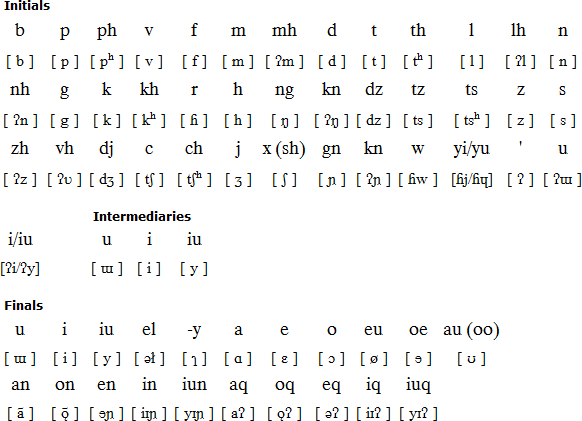Shanghainese is a dialect of Wu spoken by about 14 million people in Shanghai. There are also many Shanghainese speakers in Hong Kong. There is no standard written form of Shanghainese and it rarely appears in writing. Though the language is the everyday spoken language of Shanghai, it isn't used in education and is only occasionally heard on local radio stations.
The Common Chinese Language movement was started by Shanghai intellectuals and writers during the early 20th century to create a common vernacular medium for national communication. Mandarin was selected as the base, due to the large number of Mandarin speakers in China and its relative simplicity. The bulk of vernacular Mandarin Chinese literature were written not by native Mandarin speakers but by native Wu and Shanghainese speakers. As result, a lot of today's Mandarin Chinese vocabulary comes from Wu Chinese via these literary works. The words and usages have become so well adapted into Standard Mandarin that most speakers assume they are indigenous to Mandarin rather than being cognates of Shanghainese.
What the early Shanghainese proponents for a common Chinese language did not anticipate was that Standard Mandarin's promotion would be handled through the simultaneous oppression of all other Chinese regionalects, and most harshly on Wu and Shanghainese.
Recently Shanghainese has become popular in Shanghai's underground music scene as something that challenges the dominance of Mandarin and Cantonese in music.


The normal tone is not marked, eg bin, the long tone is marked with an h or r, eg chih, and the short tone is marked with a q, eg zaq.
Download an alphabet chart for Shanghainese (Excel)
Hū’in, an alternative Romanization system for Shanghainese devised by Arthur Thompson
Details of a unified Romanization system for Wu Chinese based on Shanghainese devised by Sébastian Gantois (PDF, in French)
人人生而自由,拉尊严脱仔权利上一律平等。伊拉有理性脱仔良心,并应以兄弟关系个精神相对待。
Nyin nyin sen r yeuzy, lah nyietsen thehtsy jioeli zaon ihlih binten. I lah yeu lisin thehtsy liansin, bin in i shiondi kuaeci geh tsinzen sian tede.
All human beings are born free and equal in dignity and rights. They
are endowed with reason and conscience and should act towards one another
in a spirit of brotherhood.
(Article 1 of the Universal Declaration of Human Rights)
Information about Shanghainese | Phrases | Numbers | Books about Shanghainese on: Amazon.com and Amazon.co.uk [affilate links]
Information about Shanghainese
http://en.wikipedia.org/wiki/Shanghainese
http://www.shanghainese.info
Online Shanghainese lessons
http://www.fyan8.com/shanghai/
https://www.memrise.com/course/256754/shanghainese-with-audio/
https://mangolanguages.com/available-languages/learn-shanghainese/
https://chinesepod.com/library/courses/shanghainese/13
Shanghainesee pronunciation
http://www.wuunion.com/home/html/wugniutzyseq1/2009/0831/7.html
http://edu.sina.com.cn/l/2001-09-10/15828.html
Shanghainese dictionary
http://wu-chinese.com/minidict/search.php
上海人 | 世界第一上海前沿文化平台 - Top Shanghai youth culture portal
http://www.shanghaining.com
Dungan, Cantonese, Fuzhounese, Gan, Hakka, Jian'ou, Mandarin, Puxian, Shanghainese, Taiwanese, Taiwanese Hakka, Teochew, Weitou, Wenzhounese, Xiang
Written Chinese: Oracle Bone Script, Simplified characters, Bopomofo, Types of characters, Structure of written Chinese, Evolution of characters, How the Chinese script works, Xiao'erjing, General Chinese
Spoken Chinese: Mandarin, Dungan, Wu, Shanghainese, Wenzhounese, Yue, Cantonese, Weitou, Min, Jian'ou, Taiwanese, Teochew, Fuzhounese, Puxian, Hakka, Xiang, Gan, How many people speak Chinese?
Other Chinese pages: Chinese numbers (數碼) | Chinese classifiers (量詞) | Electronic dictionaries | Chinese links | Books: Chinese characters and calligraphy | Cantonese | Mandarin, Shanghainese, Hokkien and Taiwanese
Akkadian Cuneiform, Ancient Egyptian (Demotic), Ancient Egyptian (Hieratic), Ancient Egyptian (Hieroglyphs), Chinese, Chữ-nôm, Cuneiform, Japanese, Jurchen, Khitan, Linear B, Luwian, Mayan, Naxi, Sawndip (Old Zhuang), Sui, Sumerian Cuneiform, Tangut (Hsihsia)
Page last modified: 15.03.23
[top]
You can support this site by Buying Me A Coffee, and if you like what you see on this page, you can use the buttons below to share it with people you know.

If you like this site and find it useful, you can support it by making a donation via PayPal or Patreon, or by contributing in other ways. Omniglot is how I make my living.
Note: all links on this site to Amazon.com, Amazon.co.uk
and Amazon.fr
are affiliate links. This means I earn a commission if you click on any of them and buy something. So by clicking on these links you can help to support this site.
[top]